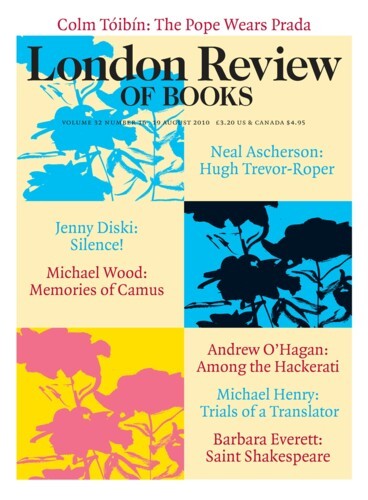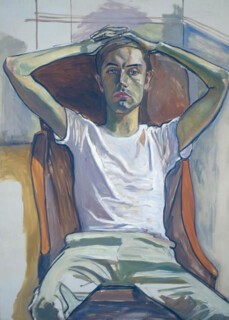In Painted Truths, at the Whitechapel until 17 September, there are nearly 70 oils by Alice Neel, mainly portraits. There is also a very good film by her grandson Andrew Neel about her work and about the Neel family. It includes photographs and clips in which she looks like the model for a Norman Rockwell grandmother: grey hair pulled back, plump, smiling, wearing glasses, and pretty. To a degree she was all that that implies. Her sons loved her and went on doing so, but there were things to put up with. Hers wasn’t a trouble-free life: mental breakdowns, changing partners, and lack of money told. The sons had no reason to love the bohemian life and showed it: one became a lawyer, the other a doctor.
Painting, Neel said, was ‘something she had to do’, there was no other way of living, and for most of her life it didn’t make her much of one. A nude self-portrait begun in 1975 (she was born in 1900 so her decades are the century’s decades) shows a different grandmother figure. Her face is rather tight around the mouth, as a painter’s face can be when reaching a decision about just how a detail seen in the mirror can be put down with the next stroke. She sits in a blue-striped chair, her old flesh drooping and bulging around her as old flesh does. Jeremy Lewison in the catalogue calls it a ‘brutally frank self assessment’, ‘the obverse of a pin-up girl’. But brutal is the wrong word. It is certainly truthful about how things look, selectively truthful in the things it chooses to emphasise or simplify, aggressive perhaps, in the way of people who can’t refrain from saying awkward things out loud about guests at a party. But not brutal.
The picture was finished because she was asked to participate in an exhibition of self-portraits, but it wasn’t painted for that reason. If there was a desire to shock it wasn’t opportunistic. She is nude, as Joe Gould is in the portrait she painted of him in 1933, because nakedness was a necessary part of the subject. Gould, who panhandled his way through the New York bohemia in which Neel eked out a living, eventually found fame of a sad sort in ‘Professor Seagull’ and ‘Joe Gould’s Secret’, two wonderful New Yorker profiles by Joseph Mitchell. In a 1946 letter to Mitchell, Gould wrote that he
ran into a young painter I know and his wife … they had recently gone to a party in the studio of a woman painter named Alice Neel, who is an old friend of mine … Alice showed them a portrait of me she did some years ago. I asked them what they thought of it. The young painter’s wife spoke first. ‘It’s one of the most shocking pictures I’ve ever seen,’ she said. And he agreed with her. ‘You can say that again,’ he said. This pleased me very much, especially the young man’s reaction, as he is a hot-shot abstractionist and way up front in the avant garde and isn’t usually impressed by a painting unless it is totally meaningless and was completed about half an hour ago.
Years later, when Mitchell was considering working on the second profile, he called on Neel: ‘The address turned out to be a tenement in a Negro and Puerto Rican neighbourhood on the Upper East Side … Against a wall in one room was a two-tiered rack filled with paintings resting on their sides … As she took them out, she held them up for me to see, and commented on them, and her comments were so offhand they sounded cryptic.’ The pictures Mitchell remembered are in the Whitechapel exhibition: Dead Father (her father in his coffin), T.B. Harlem (the brother of José Negron, her companion during the late 1930s, in hospital) and Childbirth. And there was Joe Gould.
Then came a painting of a small, bearded, bony, gawky, round-shouldered man who was strip stark naked except for his glasses … He had one set of male sexual organs in the proper place, another set was growing from where his navel should have been, and still another set was growing from the wooden bench. Anatomically, the painting was fanciful and grotesque but not particularly shocking; except for the plethora of sexual organs, it was a strict and sober study of an undernourished middle-aged man. It was the expression on Gould’s face that was shocking. Occasionally, in one of his Village hangouts … his eyes would glitter, his lower jaw would hang loose like a dog’s in mid-summer.
She said to Mitchell: ‘I call it Joe Gould. But I probably should call it “A Portrait of an Exhibitionist”,’ since ‘there was an old exhibitionist shut up inside him and trying to get out.’ The face in the picture removed the doubts Mitchell was having about going on with the profile. ‘I concluded that if it was possible for the real Joe Gould to have any feeling about the matter one way or the other he wouldn’t be in the least displeased if I told anything at all about him that I happened to know.’ The show of multiple genitalia in the Gould portrait that shocked the young abstractionist wasn’t just a ploy to get attention. Attention was certainly in short supply, but in later pictures – Margaret Evans Pregnant, for example, or the 1970 portrait of Andy Warhol, stripped to the waist, showing the scars of his 1968 gunshot wounds, or in any of the other pictures where people have taken off their clothes – you know that if you weren’t shown the body you wouldn’t know what the portrait meant.
Andrew Neel, talking about his grandmother’s situation, says that ‘working on something which is unfashionable is hell.’ Those New York painters she spent time with who became successful in the 1940s and 1950s were mostly abstract expressionists. She was known, but not much shown. Later, she made an effort to do something about it: in the exhibition, the 1960 portrait of Frank O’Hara is evidence of that – he was a curator at the Museum of Modern Art as well as a poet – but he never helped her get shown or wrote about her. It wasn’t until the 1970s, when the rise of feminism led to revaluations of women who had been overshadowed in a male-dominated art world, that her profile rose. Her portrait of Kate Millett was on the cover of a ‘Politics of Sex’ issue of Time in 1970 and there was a retrospective at the Whitney Museum of American Art in 1974.
In her best pictures faces are loaded with information about attitudes and emotions. They address you, the viewer (who stands where the painter did), and demand that you understand how they feel. Much of the time you confront trouble or anxiety. The 1966 portrait of her son Hartley shows him, hands joined over his head, looking straight at you while sitting slumped back in a chair. He had started medical school and had told Neel at the time she was painting it that he could not bear dissecting a corpse and would have to give it up. In the end he got his degree, but the sense of crisis is powerful. You wouldn’t be surprised if you were told he had been crying. The 1958 portrait of his father, Sam Brody, was painted in the year he and Neel ended a long, sporadic relationship. Arms crossed, eyes not meeting yours (hers), a strong crease created between frowning eyebrows: you read a troubled man who could also be trouble.
There is no easy way of knowing how true such readings are; but the best of her portraits share with few others (Goya’s Don Andréas del Peral in the National Gallery is one) a degree of concentration on expression that transmutes likeness into presence. In one way she was free as most portrait painters are not: she asked people to sit, they didn’t ask her. She needed their time but not their approval. Not that her way of painting has anything in common with Goya’s. By the 1970s she had settled to a style in which drawing in dark blue was filled in with Cézanne-like dabs – a graphic artist’s solution as much as a painter’s. That way of putting down the facts of human expression came late, but the relation to her subjects goes far back. In an early portrait, Ed Meschi (1933), pale blue eyes from a dark face question the painter. The pose – the head is bent to one side, as though peering round the canvas in front of him – emphasises the exchange between painter and subject that is taking place. Around the same time, just released from hospital following a mental breakdown brought on by the death of her first daughter and her separation from the second, she painted Symbols (Doll and Apple). It is odd, handsome and disturbing; but in the end it was the disturbance seen in the faces of others that she turned to.
The earliest landscapes are street scenes like Ninth Avenue El. Later ones are Hopper-like views from windows of the apartments she lived in, showing the walls and windows that surrounded them. The rooms she worked in are thus defined by views from them. In so far as the life she lived there is illustrated, it is in the portraits of children, grandchildren, partners, friends, neighbours, near strangers, other artists, writers, nearly all painted in light from those windows. Many of the portraits are of people under stress – a young mother newly responsible for a child, old men doubtful about the future. The ‘stately, soft-spoken, good-looking blonde woman in her middle fifties’ Mitchell visited had found a way of showing what people look like that would carry her through waves of style and fashion. It seems that painting for her was an attitude to people. I finished believing that she did indeed, as the exhibition title has it, ‘paint truths’.
Send Letters To:
The Editor
London Review of Books,
28 Little Russell Street
London, WC1A 2HN
letters@lrb.co.uk
Please include name, address, and a telephone number.


